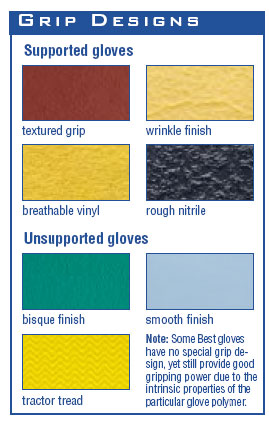Best® is the most accomplished innovator and manufacturer of disposable hand protection ever. The first to create disposable nitrile and accelerator-free nitrile hand protection – we offer the broadest line of disposable choices available within the industry.
Polymers
Naturally occurring and man-made polymers are essential building blocks of hand protection. Specific polymers protect workers from specific hazards. There is no ideal glove that works in every situation. Best utilizes a variety of polymer coatings and fabrics, designed for a variety of tasks.
Natural Rubber
Natural Rubber, the most elastic substance known is found in over two hundred plants including the rubber tree (Hevea Brasiliensis), the source of natural rubber latex used to manufacture some Best gloves. Natural rubber is a flexible and soft, yet tough and durable coating that provides excellent protection from physical hazards and provides an outstanding grip. Natural rubber provides excellent protection from exposure to aqueous chemicals such as acids and caustics, and limited protection from alcohols and ketones. Natural rubber gloves do not hold up well in organic solvents, oils, greases or fuels such as kerosene or gasoline.
CAUTION: Natural rubber latex has been shown to cause allergic reactions in sensitized individuals.
Neoprene® (Polychloroprene, CR)
Strong, durable Neoprene gloves provide excellent protection from physical hazards such as cuts and abrasions and also provide excellent chemical resistance for protection from exposure to organic and inorganic acids. Neoprene gloves also provide excellent protection from many organic solvents, oils, greases and petrochemicals and resist degradation from ozone, sunlight and oxidation. In addition, Neoprene remains functional and flexible at temperatures ranging from -10° to 300° F (-23° to 150° C).
Neoprene® is a registered trademark of Dupont
Nitrile (Acrylonitrile-Butadiene rubber)
Nitrile, a versatile synthetic copolymer, is used to make a variety of gloves ranging from heavy duty work gloves to ultra-thin medical and clean room gloves. Nitrile coating provides tough protection from physical hazards such as cut, puncture or abrasion. Nitrile dipped gloves also provide chemical resistance to petrochemicals (especially fuels), oils, greases, pesticides and other agricultural chemicals while providing excellent dexterity.
PVC (Polyvinyl Chloride)
PVC is an economical synthetic thermoplastic polymer that is exceptionally durable. PVC gloves provide excellent protection from limited chemical exposure and physical hazard protection. They are noted for being durable and function well in temperatures ranging from -30° up to 212°F (-34° up to 100° C).
Butyl (Butyl Rubber)
Butyl Rubber’s tight molecular structure provides excellent chemical resistance to gases and ketones. Butyl gloves are manufactured in unsupported version only and are used by the military for protection from chemical warfare agents. Butyl rubber is severely affected by exposure to fuels and aliphatic and aromatic hydrocarbon solvents.
Viton® (Fluoroelastomer)
Viton provides excellent chemical resistance to fuels used in the aerospace industry. It provides excellent protection from exposure to aromatic hydrocarbons such as benzene, toluene or xylene. Viton gloves are available in unsupported version only. For working with extremely hazardous chemicals such as carcinogenic or highly toxic chemicals, Viton works where no other glove works. Viton® is a registered trademark of Dupont.
Polymer Combinations for the Best® of Both Worlds
Certain combinations of polymers are used to make hybrid gloves that feature Neoprene over natural rubber latex gloves that are used in Best Chem Master™ gloves. Viton® over Butyl is used to make the highly chemical resistant Best Viton® II glove. Nitrile is used as an overdip in several Best natural rubber gloves to provide added resistance to aging, ozone and chemicals.
 |
Disposable Gloves: This category of unsupported gloves is generally characterized as a thin-gauge glove that is not intended for repeated use. They may have a donning agent such as powder or may be powder-free.
Laminated Gloves: This special nitrile-coated fabric is made by transfer-coating the nitrile polymer onto a textured surface and then laminating the nitrile film onto Sanitized® poly-cotton fabric for superior comfort and flexibility.
Impregnated Gloves: This special nitrile or PVC-coated fabric is made by knife-coating nitrile or PVC directly onto Sanitized® cotton fabric.
Supported Gloves: These gloves offer a polymer coating over a cotton, nylon or aramid liner. The textile substrate imparts added strength and resistance to abrasion, cuts and punctures.
Unsupported Gloves: These are polymer gloves with no textile lining. These gloves include heavyweight, medium weight or disposable gloves. They may be chlorinated or have a cotton flock lining for easier donning.
Cut Resistant Gloves: This special category is characterized by the utility of the gloves and includes either polymer coated gloves or special high performance yarns that are designed to impart cut-resistance or combinations of these.
|
GLOVE SIZE CHART

|
Knitwrist: designed to keep glove firmly in place, prevents debris from entering glove, enhances warmth, should not be used where quick glove removal is needed.
Safety Cuff: allows glove to slide on and off easily, helps protect wrist, releases quickly from hand, won’t soften when exposed to perspiration or washing.
Gauntlet: provides additional protection for lower forearm, allows maximum forearm dexterity, lets glove slide on and off easily, protects wrist, releases quickly from hand.
Note: Unsupported gloves may have a rolled cuff, a serrated cuff or a straight cuff.
Color Coded Cuffs: Many of our styles have color-coded cuffs for easy size identification and pairing after laundering.

|
|